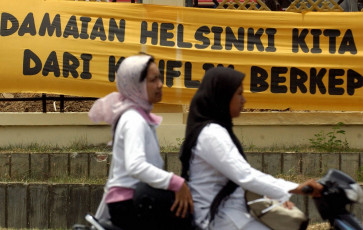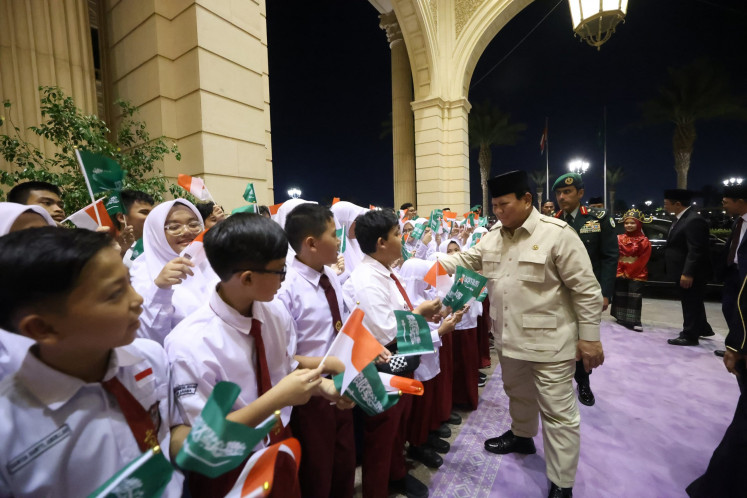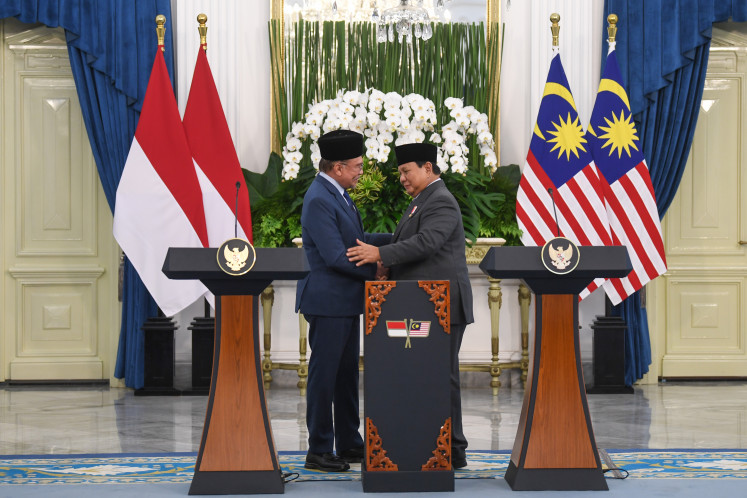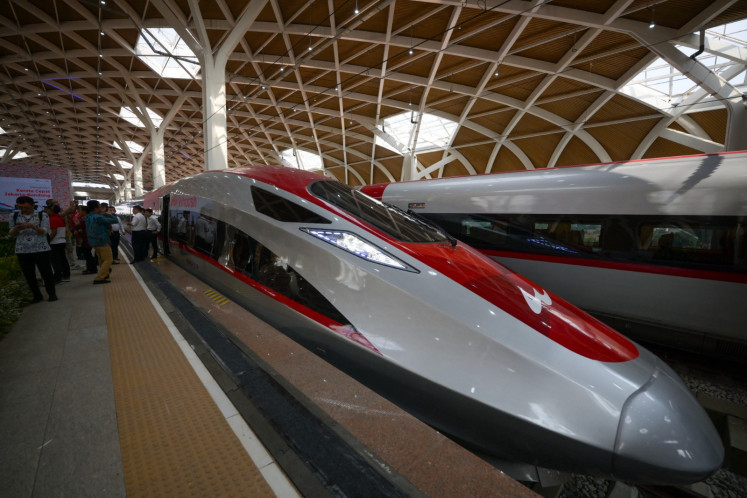Popular Reads
Top Results
Can't find what you're looking for?
View all search resultsPopular Reads
Top Results
Can't find what you're looking for?
View all search resultsPapua shootings under international spotlight
The latest shooting incidents, injuring 55-year-old Dietmar Pieper in Jayapura and killing 36-year-old Antun Arung Tambila in Puncak Jaya, indicate a continued relapse into violence, regular episodes of insecurity and the sustained maintenance of low-intensity conflict in the region by belligerents
Change text size
Gift Premium Articles
to Anyone

T
he latest shooting incidents, injuring 55-year-old Dietmar Pieper in Jayapura and killing 36-year-old Antun Arung Tambila in Puncak Jaya, indicate a continued relapse into violence, regular episodes of insecurity and the sustained maintenance of low-intensity conflict in the region by belligerents.
Although foreign nationals are rarely targeted, previous shootings targeting Australian as well as US citizens associated with the gold mining giant PT Freeport Indonesia have impacted negatively on international public opinion and have raised questions on wider bilateral relations between other countries and Jakarta.
The recent UN Universal Periodic Review in Geneva saw a number of countries change their stance regarding Indonesian policies in Papua and questioned Jakarta’s commitment to human rights in
the region.
Unidentified shootings have been on the rise since 2009 with a wide range of victims that includes major mining operation personnel, private security officers, police officers, local tribal groups and leaders, commercial airlines, teachers, local journalists and even motorcycle taxi drivers.
Taking into consideration the geographical, political, and tactical signatures of these attacks, it is highly likely that more than one belligerent group is involved.
Furthermore, a repeat of these incidents will no doubt taint Jakarta’s international image, hinder various efforts in building trust among stakeholders in Jakarta as well as Papua and might even impede the concerted push toward dialogue that is intended to address the multitude of Papuan grievances.
Geographically, although extremely dispersed, most signature attacks by the Free Papua Organization or its military wing (OPM/TPN) are usually carried out by its relatively active regional commands located in Puncak Jaya, Timika-Wamena and Bewani.
In the near future, a fourth potentially active command structure might also be consolidating itself in the Paniai region. This is due to the failure of security forces to embrace and include local indigenous tribes in sharing the spoils of the semi-legal gold panning activities, the continued radicalization of Papuan students and youth through cases of unnecessary violence, and the region’s relative proximity to the influence of nearby active OPM/TPN commands.
The police’s Mobile Brigade (Brimob) have also been accused of disproportionate violence by international observers, but these are mostly confined to geographically lucrative logging sites and/or gold panning sites such as those located in Mimika and Paniai while military excesses are often found in Puncak Jaya or in proximity to Jakarta’s national strategic objects (obvitnas) in Mimika.
Therefore, unless the political and tactical signatures are identical, the link between two geographically distinct locations, such as that of Jayapura and Puncak Jaya, should only be made after very careful consideration.
Politically, each of the OPM/TPN commands has its own preference of targets. For instance, the Timika-Wamena command is in charge of staging attacks to disrupt Freeport’s Grasberg mine operations as well as to discredit the security services provided by the Indonesian Military (TNI) and/or police to the company.
The Bewani command, located across the border in Papua New Guinea, focuses on attacking non-Papuan settlers and TNI forward posts in proximity to the border while disrupting “sterilized zones” set up along the borders. The Puncak Jaya command directly engages in asymmetric warfare with the TNI, often raiding military posts and police convoys to secure weapons as well as ammunition.
Although OPM/TPN does have an interest in displaying Jakarta’s lack of control and inability to provide stability and security for the region, assaults on foreign nationals are unlikely due to their current attempt to win supporters as well as sympathizers from abroad.
Nevertheless, taking into consideration the current rate of political fragmentation and discord within its ranks, we should also not assume a monolithic Papuan military command that always goes hand-in-hand with its diplomatic efforts.
Similarly, the military has very little motivation to internationalize the issue unnecessarily. Previous public condemnations and the loss of foreign support resulting from the death of foreign nationals and international pressure to investigate the deaths, along with the memory of the Santa Cruz incident, which indirectly provoked the loss of East Timor, are likely to ensure that foreign nationals remain the most troublesome and least desired targets for violence in Papua.
Competing interests within the military, institutional rivalries between the military and the police, as well as Papua’s extreme geographical distance from Jakarta have helped create a “fog of conflict” that renders media scrutiny and centralized democratic control of the state apparatus difficult from Jakarta.
Tactically, there are three main shooting signatures. Shootings either employ (1) an efficient “clean kill” intended to instantly neutralize unsuspecting targets up close or at distance, sometimes seen in a number of attacks targeting the police and mining personnel, (2) a more “sloppy shooting” sees targets being sprayed with numerous bullets by less skilled shooters, and is often the work of the OPM/TPN, or (3) an “intimidation shooting” that is done in the open with a number of projectiles hitting the target, inflicting injuries, but resulting in low fatalities, similar to those that recently happened in Paniai.
Differentiating between these signatures, however, becomes impossible with the possibility of more than one group being involved in the same attack.
Local demands for the police to identify the ammunition used in the attacks will serve very little use. Although the OPM/TPN does not pose a serious security threat, its arsenal does include a very small number of grenades, petrol bombs, and also SS-1 assault rifles and 7.62 mm AK-47s gained from raids, which unfortunately means that they will then share the same 5.56 mm bullets used by M-16, Steyr, SS-1, and the 7.62 mm bullets used by AK-47 assault rifles that are issued to both the military and the police.
Considering the geographical, political and tactical signatures of attacks, several points can be concluded. First there are indications that more than one party is involved in these unidentified shootings.
Second, as many stakeholders (including major businesses, foreigners, civilians, indigenous groups and the police) have at one point or another become victims to these shootings, tensions will remain high and will continue to pose a challenge for building trust and confidence.
Third, taking into consideration the abundance of organic and illegal firearms along with the ease of gaining permits for them in Papua, the possibility of several attacks being criminal, non-political, individual, and detached from any organization’s political goals should also not be ruled out.
Immediate action is needed to address the situation and dialogue will need to happen amid these incidents. Due to the limited information available, observers can only speculate at best on the identity and motivations of the perpetrators. Proponents of reconciliation, at home and abroad, will now need to take these unidentified shootings into calculation and design a mechanism to mitigate the future role of these shootings as potential spoilers of dialogue.
The writer is program director of Pacivis and the Papua Center in the Faculty of Social and Political
Sciences at the University of Indonesia, Depok, West Java.









